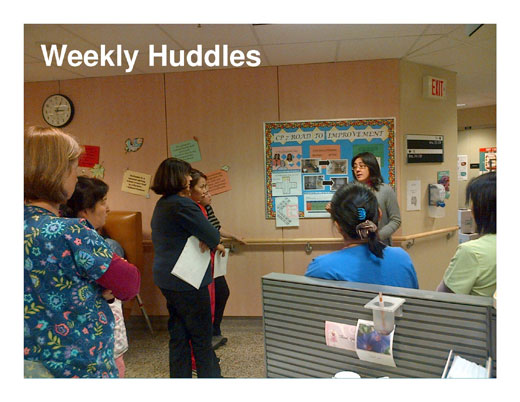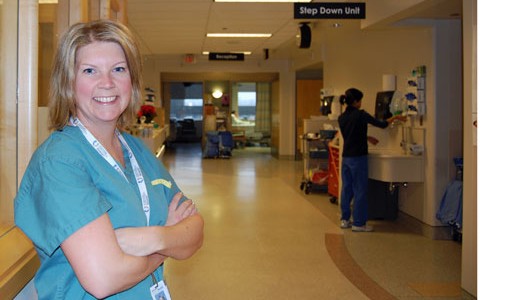CDI cases plummet across four more VGH units
You can’t argue with these numbers.
Five units once home to three-quarters of all hospital-acquired C. difficile infections (CDIs) at VGH have reduced their number of CDI cases from 18 in September to 5 in November — that’s a 72 per cent drop in just two months.
Following Acute Medicine’s successful pilot on T10C (read their story here), the hospital’s CDI Initiative has now rolled out with jaw-dropping results on VGH units CP7, CP8, T8 and T11. Staff enthusiasm and elbow grease have produced cleaner, safer units for patients, families and staff — not to mention the environment to provide best care.
“Without isolation requirements, staff can focus more time on the original reasons patients were admitted to hospital,” says Melissa Crump, infection control practitioner.
Decluttering a visible starting point

Susan and her colleagues had input into the set up of new PPE carts, including wall-mounted Cavi wipes within easy reach.
It all begins with de-cluttering and on T8 RN Susan Sandberg led the charge, attacking patient and family lounges, supply and storage rooms, nursing stations, hallways and patient rooms.“It’s amazing how many supplies are lying around,” she says. “De-cluttering has increased our focus on cleaning up after ourselves. Staff’s awareness of ways to reduce infections is more apparent now.”
In addition to de-cluttering, all units enhanced their hand hygiene, and they’ve all received tools for success: new shelving, patient room bins, personal protective equipment (PPE) carts and — count ’em — one mobile patient monitor for every nurse on shift.
Preventing clutter creep and keeping clean
Clutter can creep back, so checklists and a concerted effort are helping units stay clean. “Our charge nurse assigns one nurse and one care aide to keep it up every day,” says Grace McKay, a T11 patient care aide. “As soon as you enter, you see it’s really clean; it makes your job a little bit easier.”
Every 12-hour shift has two persons assigned to conduct maintenance de-cluttering. “It’s becoming a routine for all of us to do the cleaning,” adds LPN Teresita Rafol.

Regular huddles at each unit’s infection control focus board help keep units clean and provide time for problem-solving.
Regular huddles at each unit’s infection control focus board also helps to keep everyone, well, focused. Patient Care Aide Jessica Coulter-Brown is one of four people who rotate leading a 15-minute weekly huddle for all staff on the Sub-Acute Medicine unit. They review posted CDI and hand hygiene reports and discuss issues raised by staff.
“Our goal is to get down to one new hospital-acquired CDI case per month,” Jessica says, “but we’ve now gone five weeks with no new cases.”
Partnerships key to success
Preventing CDIs is a clear example of providing the best care and putting People First — and it takes a lot of people to achieve this level of success.
In addition to our infection control experts and clinical educators, success would not be possible without the dedication and support of Maintenance, Biomedical Technology and our Aramark partners.
With their support, we’re well on our way to addressing one of the areas Accreditation Canada surveyors noted for improvement: de-cluttering.

